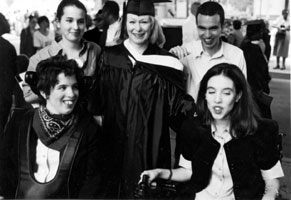|

Mary
Somoza: Mom, Special Ed Advocate and College Grad
By Tom Kertes
As
Sept.11 has taught us, heroes come in all shapes, sizes, and forms.
In the case of Mary Somoza, heroism comes in the form of a blonde-haired
woman with an Irish accent who’s fought the powers that be every
step of the way to get equal treatment for her children.
“I’m
no hero,” Somoza says in her typically self-effacing manner. “They
are your kids. You do what you have to do.”
Somoza did what she had to do because her twins, Alba and Anastasia,
suffer from cerebral palsy and have been quadriplegics from birth.
And because the public education system is able – but not always
ready or willing – to serve the needs of children with special
needs.
Back in 1993, Somoza’s original fight with the New York City Board
of Education was for the simple inclusion of her daughters – along
with the acquisition of the necessary support services – into
the mainstream program at P.S. 234. That fight turned out to be
successful, but it was nothing compared to the bureaucratic battle
Somoza needed to wage in order to send the twins to District 2’s
“School of the Future” junior high school in 1996.
“I
was 100 percent committed to the girls going there,” said Somoza.
“It was the ideal place. First of all, the school was very technology
oriented, with a highly advanced computer program, and this was
a necessity for the twins’ functioning in the optimum manner.
Alba, in particular, is completely dependent on a computer for
her communication needs. And, secondly, this was a junior high/high
school, obviating the need for another transition into high school.
Transitions are extremely difficult for children with special
needs.”
The problem was wheelchair accessibility – a ramp, a single-unit
door, a simple curtain in the bathroom. District 2 claimed it
was impossible to accomplish this for anything less than $1.2
million.
“This
seemed ridiculous to me,” Somoza said. “And it seemed even more
ridiculous when they refused to show me the report this absurd
estimate was allegedly based upon.”
Somoza went ahead and prepared her own architect’s report. The
cost turned out to be a meager $15,000! “I couldn’t have done
it without the Eastern Paralyzed Veterans’ Association and the
New York Lawyers in the Public Interest,” she said. “But I had
to find those organizations first. So I networked. And then I
networked some more. I went and lobbied and argued and asked for
help until I got what I needed. Until there were no more excuses.”
The school has been great. “It’s been a total change from all
the years of fighting,” said Somoza. “There was still a lot to
do. But now I could work with the school – rather than constantly
challenge the system – to acquire the necessary things.”
While the twins’ academic experience turned out to be fantastic
– they’re both honor roll students – their social experience was
less so. “There have been many promises and dates broken, kids
let the girls down a hundred times,” said Somoza. “Sure, I know
how teenagers can be. But the thing I don’t understand is that
when Anastasia attended Yale University over the past two summers
– she participated in a Junior Statesman program – she made dozens
of friends so easily.”
The girls now face their college choices. Anastasia, the less
handicapped twin who is quite independent once she gets into her
wheelchair, has already been accepted to a couple of top Northeastern
schools, but still hopes to go to Yale. “Yale has wonderful accommodations,”
said Somoza. “In addition, we are also applying for a Home Health
Aid and the use of a service dog. She should be just fine.” Alba,
who is non-verbal, can’t use her hands, and needs a computer to
communicate, has been accepted into a special program at Queens
College. “Now, of course, I’m getting grief about transportation
‘to a different borough’ from the powers that be,” said Somoza.
“But I’m not going to stand for it. Whatever it takes, I will
get it. My child will get the education she’s entitled to if it’s
the last thing I do.”
Not surprisingly, Somoza’s rule of thumb is “nothing is impossible.”
“My advice to parents in similar situations is, “Attack the problem!”
she said. “Educate yourself. Know your rights. Talk to people.
Network. And don’t let the Board of Education or any other bureaucracy
tell you that something can not be done. Your child has just as
much right to reach his or her maximum potential as any other
child does.”
“Remember,
the law says that every child is entitled to a ‘free and appropriate
public education. And that includes your child.”#
Education Update, Inc., P.O. Box 20005, New York, NY 10001. Tel:
(212) 481-5519. Fax: (212) 481-3919. Email: ednews1@aol.com.
All material is copyrighted and may not be printed without express consent of
the publisher. © 2001.
|

